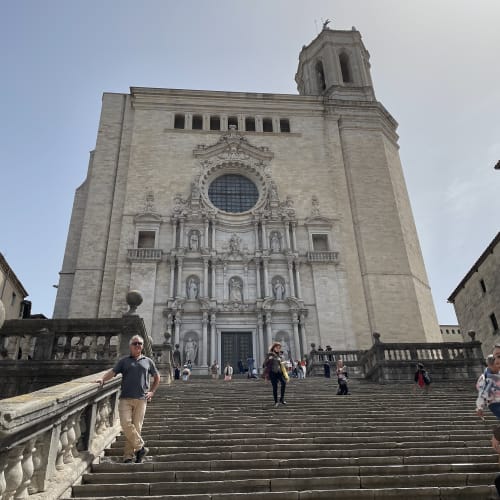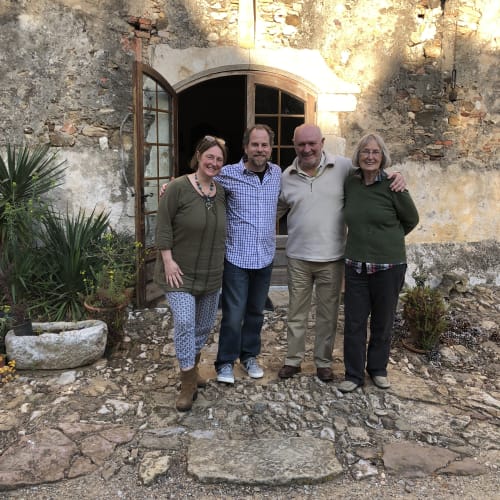A Romanesque Pyrenees Experience
Don Harris | January 2004




This area of Spain contains an amazing treasury of art and architecture, some of which stretches back over a thousand years. It has been relatively untouched because the areas of interest are largely valleys nestled in the foothills of the rugged Pyrenees. The roads are winding and difficult to navigate in the winter contributing to a place minimally touched by modern life. Romanesque architecture reigns with its solidity and Pythagorean harmony. Toward the end of this itinerary I hope you will experience the culmination of this spirituality in the twelfth century monastery of Sant Joan de les Abadessas and its Descent from the Cross wooden sculpture. Finally, you will visit Vic and be able to feast your eyes on the sculptures in the newly opened Episcopal Museum.
Day 1 - Arrival at Barcelona Airport
Fly directly to Girona and rent a car. Alternatively, you can rent a car at the Barcelona Airport and drive 2 hours to Girona, or take the train from Barcelona. The medieval section features two important sites: First climb the broad dramatic stairway to the cathedral, and the Tapestry of Creation. It is a large 11th century wool and linen panel of needlework depicting Christian creation myths. The other important site is the fascinating Sephardic Museum and Library in the Jewish Quarter. Then, drive to the Parador Aiguablava and enjoy the surf crashing against the cliffs, 22 miles east of Girona.
Day 2 - Romanyá de la Selva and Madremanya
Drive to Romanyá de la Selva to visit the church of Sant Martí de Romanyà and Cova d’en Daina, a granite dolmen large built between 1700 and 2200 B.C. Then, explore the medieval village of Madremanya. Return to Aiguablava Parador via pottery center of La Bisbal de Empordá and the gourmet olive oil finca of Can Solivera. There you will be greeted by our dear friend Hans de Roos, who will introduce you to his Can Solivera Wild Olive Oil used by the chefs at Michelin +++ restaurant Can Roca in Girona. His encyclopedic knowledge of the world of olive oil is dizzying.
Day 3 - d’El Pl’a de l’Estany Region
The next morning, visit the Castell de Rabós del Terri and the Iglesia de San Estéban in Cornellá del Terri. In San Vicente de Camós, you will find the beautiful 12th century church of Santa Magdelena de Noves. Proceed to Banyoles to see the Monasterio de San Estéban established by the Benedictines in 812 AD, built upon the remains of a late Roman church. Stay in Besalú which features arcaded streets and squares and also a restored mikveh, a ritual Jewish bath dating from the eleventh or twelfth century. There are also remains of a medieval synagogue, located in the lower town near the river at the Hotel Three Arcs.
Day 4 - Drive to Camprodón
Along the remote mountain byway you will encounter the interesting town of Tortellá where for centuries the local craftsmen have made wooden cutlery out of boxwood that is gathered in the foothills. The grain of the boxwood is even smoother than orange or olive woods. Ask around town where they are being carved.
In Montagut i Oix, you can experience a mountain town from the Middle Ages including the XI century Iglesia de San Lorenço. In Camprodón you will see a 12th century stone bridge spanning the river Ter. Be sure to take time to tour the Monasterio de Santa Maria. Stay at the Hotel Can Roc in Camprodón.
Day 5 - Beget, San Joan de las Abedesas and Ripoll
The Iglesia de San Cristófol in Beget is a national heritage site built in the tenth century is an example of pre-Pyrenean art in its purest form. The road to Beget is not difficult to drive, although the paved road is narrow. The large 12th century polychrome Majesty of Beget is considered as one of the most beautiful Romanesque carvings preserved today in Catalunya. Lost in the middle of the mountain between two streams, the entire town is an architectural monument worthy of visit. It is beautifully restored.
Then, drive to the Monasterio and Iglesia de Sant Joan de las Abadeses which captures the essence of Catalán/Benedictine spirituality in the Pyrenees, if not in all of Spain. The monastery was founded in 887 AD and contains the deeply moving sculpture of the Descent from the Cross, carved in 1250. It is considered one of the greatest examples of the Romanesque/Catalan. The altarpiece is also known by the name of the Most Holy Mystery because in 1426 some remains of consecrated hosts were found incorruptible in a reliquary hidden inside the head of Christ.
Finally, visit Ripoll and spend the night in the simple La Trobadora hotel situated close to the beautifully preserved Monasterio de Santa María de Ripoll – built in 880A.D.
Day 6 - Vic and Environs
Drive directly to the beautifully restored Museo Episcopal in Vic, where you will see medieval polychromes. There are many galleries full of Romanesque religious statuary available nowhere else in the world. It is the summary of what you have seen on this trip. Then, visit Iglesia de San Feliu de Savassona, considered one of the few monuments which exemplify how churches were built during the period of repopulation, after the Moors were defeated. Relax at the Parador Vic located on a serene lake outside of town.
Day 7 - Drive to Barcelona Airport Hotel XXXX
A little over an hour’s drive and you will be at the Barcelona – Prat Airport.
